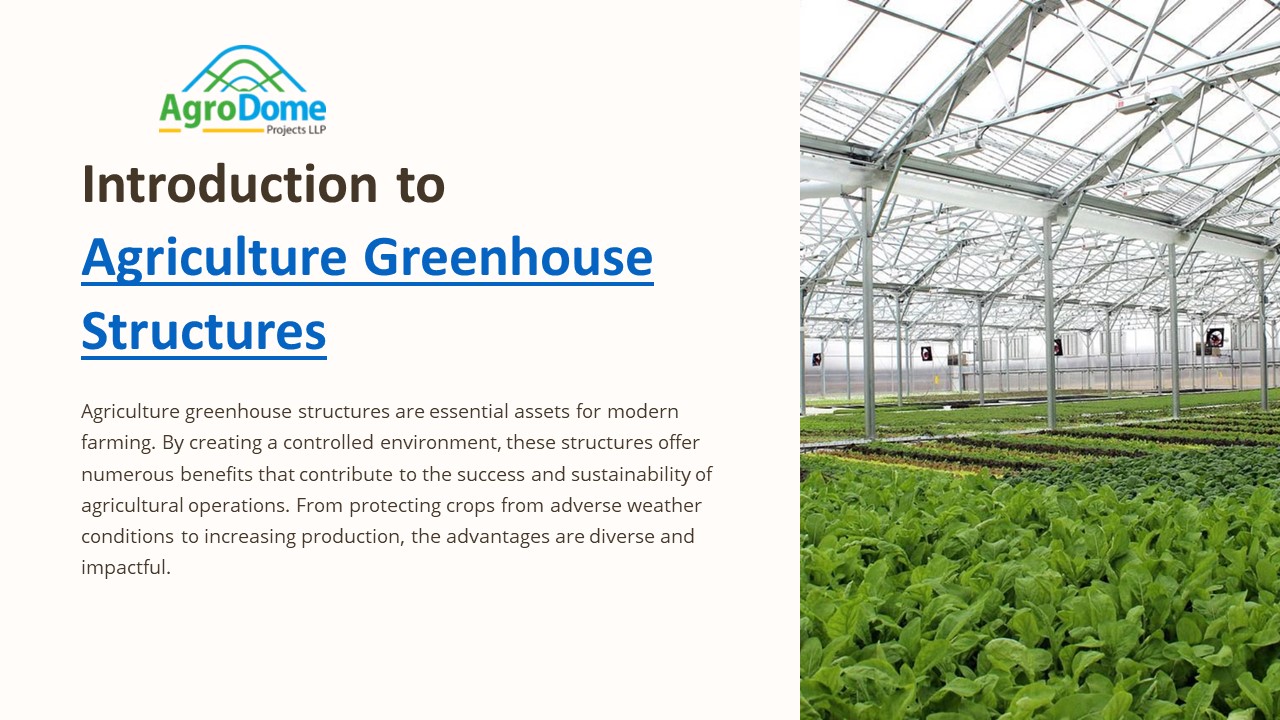Agricultural Benefits of Greenhouse Structures - PowerPoint PPT Presentation
Title:
Agricultural Benefits of Greenhouse Structures
Description:
greenhouses offer a range of benefits that contribute to increased crop production, improved food quality, resource efficiency, and environmental sustainability. Whether used by commercial growers, hobbyists, or educational institutions, greenhouses play a vital role in supporting plant cultivation and innovation in agriculture. – PowerPoint PPT presentation
Number of Views:1
Title: Agricultural Benefits of Greenhouse Structures
1
Introduction to Agriculture Greenhouse Structures
Agriculture greenhouse structures are essential
assets for modern farming. By creating a
controlled environment, these structures offer
numerous benefits that contribute to the success
and sustainability of agricultural operations.
From protecting crops from adverse weather
conditions to increasing production, the
advantages are diverse and impactful.
2
Increased Crop Production and Yield
Optimized Growing Conditions
Year-round Cultivation
Controlled Nutrient Distribution
With the ability to control temperature and
humidity, greenhouse structures enable year-round
cultivation, leading to significantly higher crop
yields compared to traditional open-field farming.
Greenhouse structures allow farmers to create
optimal conditions for different types of crops,
resulting in increased yield and improved overall
production.
Greenhouses provide a controlled environment for
precise and efficient nutrient distribution,
contributing to better crop health and increased
productivity.
3
Protection from Adverse Weather Conditions
1
2
3
Elimination of Frost Damage
Shielding from Heavy Rain
Wind Protection
High winds can easily damage delicate crops.
Greenhouses act as a barrier, offering protection
from wind-related destruction.
Greenhouses protect crops from unexpected frosts,
preventing crop damage and loss during cold
weather.
Heavy rain and flooding can be detrimental to
crops, but greenhouse structures provide a
shield, minimizing water-related damages.
4
Extended Growing Seasons
Year-round Cultivation
Greenhouses extend the growing season, enabling
farmers to cultivate crops during off-seasons and
increase overall productivity.
Early Planting
Greenhouses allow for early planting, giving
farmers a head start for certain crops and
ensuring a longer period for harvest.
Late-season Cultivation
Extended growing seasons provide the opportunity
for late-season cultivation, allowing for
multiple harvests and increased crop diversity.
5
Pest and Disease Control
Isolation from Pests
Controlled Environment
Enhanced Monitoring
Greenhouse structures create a barrier against
pests, minimizing infestations and reducing the
need for chemical pest control methods.
The controlled climate inside greenhouses helps
in preventing disease outbreaks, reducing the
risk of widespread crop infections.
With a controlled environment, it's easier to
monitor and manage potential pest or disease
issues, ensuring early detection and quick action.
6
Water Conservation and Efficient Irrigation
1
Precise Irrigation
Greenhouses enable precise water delivery,
ensuring that crops receive the right amount of
water without wastage or excessive use.
2
Reuse of Water Resources
Efficient irrigation techniques in greenhouses
allow for the reuse of water, promoting
conservation and reducing overall water
consumption.
3
Optimized Nutrient Uptake
Controlled irrigation aids in optimizing nutrient
uptake by crops, enhancing their growth and
health while conserving water at the same time.
7
Enhanced Crop Quality and Uniformity
High-Quality Produce
Uniform Growth
The controlled conditions lead to the production
of high-quality, marketable crops desirable for
consumers and retailers.
Greenhouse environments promote consistent
growth, resulting in uniform crop quality and
appearance.
8
Economic and Environmental Sustainability
Economic Viability
Environmental Benefits
Greenhouses contribute to economic sustainability
by increasing agricultural output and generating
more income opportunities.
Environmental sustainability is achieved through
reduced chemical use, water conservation, and
minimized land degradation with greenhouse
farming practices.
9
Thank You































